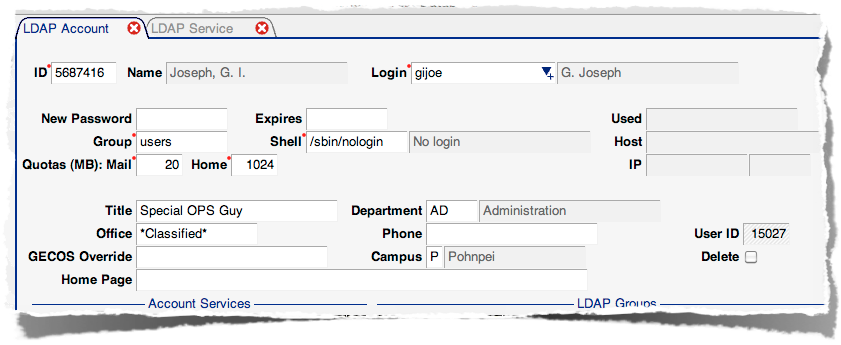|
|
LDAP IntegrationTable of contents
OverviewAccount information can be integrated with an external LDAP database to allow accounts defined within the SIS to provide authentication for e-mail, wi-fi, or other LDAP-aware services. Integration with LDAP is not required for operation of the SIS, however. Some account management functions (e.g. deleting an account) can only be performed on the LDAP Account form, but this shouldn't be taken to imply that LDAP is required or in use. AccountsEach person defined in the database can have one or more accounts associated with them. Each account has a unique login name, and may be used for access to it's own combination of services. Content at the top of the form is used for UNIX accounts or directory information:
Expires - Date the current password expires; some services will observe password expiration (not allowing an account to be used after a specific date) Group - Default group for this account; used mostly for UNIX accounts Shell - UNIX shell for account; the default of "/sbin/nologin" creates a UNIX account that doesn't allow the user to log in to the host (e.g. with ssh or sftp); if the user needs access (including for management of a web site) this will need changed to an actual shell (such as /bin/bash)
Along with a login and password, account information includes UNIX-specific data like group and shell, as well as general information like title, office location, phone number, and campus. This information is used in different ways by the services that are associated with an account. Details of how services use each field are described next. ServicesSupport for specific applications is organized around Services. The service definition is where most aspects of the LDAP integration are brought together, from an LDAP objectClass that defines what type of information should be included in the associated LDAP record, In addtion to the service code and description for an LDAP Service, these records include:
GroupsHaving LDAP Groups associated with an account offers controls for any LDAP-aware application that understands the posixGroup object class. Access to this documentation, for example, is limited to users with the sis.users group association. The LDAP AccountEach defined, active LDAP account will have one or more services specified, depending on what each account is to be used for. The accounts will all share common data from the LDAP Account form, including a password, but can supply information to multiple LDAP-aware applications. |

 Password - A new password for this account is specified here, and will be required when creating a new account
Password - A new password for this account is specified here, and will be required when creating a new account to other characteristics such as what type of password should be used (called a
to other characteristics such as what type of password should be used (called a